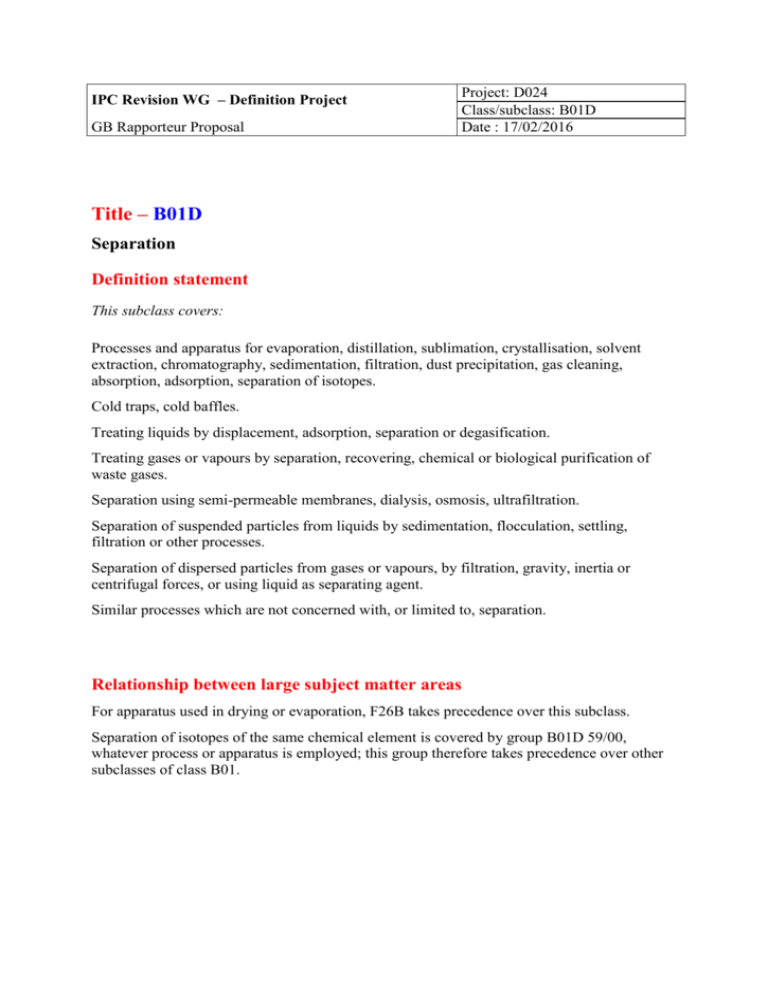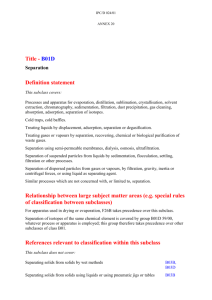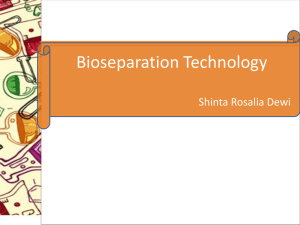IPC Revision WG – Definition Project
advertisement

IPC Revision WG – Definition Project GB Rapporteur Proposal Project: D024 Class/subclass: B01D Date : 17/02/2016 Title – B01D Separation Definition statement This subclass covers: Processes and apparatus for evaporation, distillation, sublimation, crystallisation, solvent extraction, chromatography, sedimentation, filtration, dust precipitation, gas cleaning, absorption, adsorption, separation of isotopes. Cold traps, cold baffles. Treating liquids by displacement, adsorption, separation or degasification. Treating gases or vapours by separation, recovering, chemical or biological purification of waste gases. Separation using semi-permeable membranes, dialysis, osmosis, ultrafiltration. Separation of suspended particles from liquids by sedimentation, flocculation, settling, filtration or other processes. Separation of dispersed particles from gases or vapours, by filtration, gravity, inertia or centrifugal forces, or using liquid as separating agent. Similar processes which are not concerned with, or limited to, separation. Relationship between large subject matter areas For apparatus used in drying or evaporation, F26B takes precedence over this subclass. Separation of isotopes of the same chemical element is covered by group B01D 59/00, whatever process or apparatus is employed; this group therefore takes precedence over other subclasses of class B01. References relevant to classification in this subclass This subclass does not cover: Separating solids from solids by wet methods B03B, B03D Separating solids from solids using liquids or using pneumatic jigs or tables B03B Magnetic or electrostatic separation of solid materials from solid materials or fluids, separation by high-voltage electric fields B03C Flotation, differential sedimentation B03D Separating solids from solids by dry methods, e.g. sieving, screening, sifting or using B07B gas currents Centrifuges B04B Vortex apparatus, e.g. cyclones B04C Presses per se for squeezing-out liquid from liquid-containing material B30B 9/02 Treatment of water e.g. softening of water by ion-exchange C02F C02F 1/42 Arrangement or mounting of filters in air-conditioning, air-humidification or ventilation F24F 13/28 Examples of places where the subject matter of this class is covered when specially adapted, used for a particular purpose, or incorporated in a larger system: Blood or infusion liquid filters Screens or sieves per se A61M 5/165 Extrusion filters B29C 47/68 Filtering spinning solution or melt D01D 1/10 Filtration of lubricants F16N 39/06 Suction cleaner filters A47L 9/10 Filters for breathing-protection purposes A62B 23/00 Filtering air for vehicles B60H 3/06 Separating pneumatically-conveyed materials from propelling gas B65G 53/60 Exhaust or silencing apparatus for machines or engines having means for removing solid constituents of exhaust F01N 3/02 B07B 1/00 Air cleaners for the intakes of gas-turbine or jet-propulsion plants F02C 7/05 Air cleaners for the intakes of combustion engines F02M 35/024 Air cleaners for the intakes of compressors F04B 39/16 Filtering in air-conditioning F24F 3/16 Purification or separation of nitrogen C01B 21/04 Working-up unidentified gaseous mixtures obtained by cracking hydrocarbon oils C10G 70/00 Cleaning coal gas C10K Working-up of natural gas, or synthetic natural gas C10L 3/10 Separation of difficult-to-condense gases or air by liquefaction F25J Investigating materials G01N 30/00 Treatment of milk by dialysis, reverse osmosis or ultrafiltration A23C 9/142 Treatment of milk by electrodialysis A23C 9/144 Artificial kidneys A61M 1/14 Treatment of water by dialysis, osmosis or reverse osmosis C02F 1/44 Treatment of water by electrodialysis C02F 1/469 Apparatus for enzymology or microbiology with dialysis means C12M 1/12 Production or purification of sugar juices, e.g. by osmosis C13D 3/16 Extraction of sugar from molasses, e.g. by osmosis C13J 1/08 Diaphragms for electrolysis C25B 13/00 C25C 7/04 Osmosis as energy source F03G 7/00 Places in relation to which this subclass is residual: NONE Informative references Attention is drawn to the following places, which may be of interest for search: NONE Special rules of classification within this subclass Group B01D 59/00 (separation of isotopes) takes precedence over other groups of this subclass since it covers separation of isotopes of the same chemical element, whatever process or apparatus is employed. Glossary of terms In this subclass, the following terms or expressions are used with the meaning indicated: Filtration The separation of a fluid-solid mixture, involving passage of most of the fluid through a porous barrier which retains most of the solid particulates contained in the mixture; includes straining solids from fluids. Filter medium A porous barrier or porous arrangement of material, which lets a fluid pass while retaining most of the solids which were mixed with it. Filtering element A section of filter medium in addition to parts to which the medium is demountably or permanently fixed, including other sections of medium, end caps, peripheral frames or edge strips, but excluding housings. Filter housing The fluid-constraining impervious vessel, whether open or closed, which contains, or is adapted to contain one or more filtering elements or filter media. Filter chamber The space within a housing where filtering elements or filter media are located; partitions may divide a single housing into a plurality of chambers. Filtering apparatus Filtering elements combined with housings, cleaning arrangements, motor or like parts, which are characteristic of the particular type of apparatus. Ancillary devices such as pumps or valves are considered part of a filtering apparatus when inside the apparatus. Ancillary devices performing similar or different unit operations such as comminutors, mixers or non-filtering separators, whether or not inside the apparatus, are not considered part of a filtering apparatus. The term does not extend to apparatus, e.g. washing machines, of which the filter forms only a part. Synonyms and Keywords In patent documents the following abbreviations are often used: NONE Title – B01D 15/00 Separating processes and apparatus involving the treatment of liquids with solid sorbents Definition statement This main group covers: Treating liquids with moving adsorbents. Non-selective adsorption treatment of liquids with ion-exchange materials in processes where no ion-exchange occurs (e.g. purification or regeneration treatments). Selective adsorption treatments of liquids with ion-exchange materials as adsorbents. Separation processes and apparatus using selective adsorption e.g. chromatography. Relationship between large subject matter areas None References relevant to classification in this subclass This main group does not cover: Separating processes involving the treatment of liquids with liquid sorbents B01D 11/00 Preparative gas chromatography B01D 53/02 Separation of isotopes of the same chemical element B01D 59/00 Sorbent materials in general B01J 20/00 Sorbents for chromatography B01J 20/281 Ion-exchange processes or materials B01J 39/00 to 49/00 Treatment of water - e.g. softening of water by ion-exchange C02F C02F 1/42 Investigative or analytical chromatography G01N 30/00 Informative references Attention is drawn to the following places, which may be of interest for search: Sorption and chromatography relating to particular applications, or relating to treating particular compounds or groups of compounds, may be classified in the following non-exhaustive list: Modifying dairy products by dialysis, osmosis, filtration or ion-exchange Treating blood or products derived therefrom Separation of optically active compounds Purification of hydrocarbons by adsorption Extraction, separation or purification of peptides by chromatography Refining hydrocarbon oils with solid sorbents Refining fats or fatty oils by adsorption Purification of alcoholic beverages with ion-exchange or adsorption material Separating or purifying micro-organisms or enzymes Purification of sugar juices using adsorption agents A23C 9/14 A61K 35/14 C07B 57/00 C07C 7/12 C07K 1/16 C10G 25/00 C11B 3/10 C12H 1/04 C12N 9/00 C13D 3/12 Special rules of classification within this main group In order that group 15/08 may provide a basis for a complete search with respect to chromatography, all subject matter of interest should also be classified in this group even when it is classified primarily in application-oriented place(s) (see Informative References). Glossary of terms In this subclass, the following terms or expressions are used with the meaning indicated: Adsorption A separation process which involves the transfer and resulting equilibrium distribution of one or more solutes between a fluid phase and adsorbing particles. Sorbent A material which separates a constituent from a fluid mixture containing such constituents. The action in most instances is that of selective retention (i.e. the sorbent removes only the part of the fluid mixture for which it has the greatest affinity). The retained constituent cannot be removed by shaking, brushing or similar mechanical action, but generally can be removed by heating, pressure reduction, or use of a stripping or denuding fluid. Chromatography A process in which a liquid is flowed along a linear path comprising a sorbent, with which the liquid competes in affinity for a constituent of the liquid. The constituent is sorbed from the moving liquid by the relatively immobile sorbent and re-dissolved by a later passing portion of the liquid until an equilibrium of the sorbing-dissolving step is set up causing the constituent to concentrate in a specific volume of the sorbent and to move along the path of the liquid at a rate slower than such liquid. Adsorption chromatography Separation is based mainly on differences between the adsorption affinities of the sample components for the surface of an active solid. Partition chromatography Separation is based mainly on differences between the solubilities of the sample components in the stationary phase (gas chromatography) or on differences between the solubilities of the components in the mobile and stationary phases (liquid chromatography). Exclusion chromatography Separation is based mainly on exclusion effects, such as differences in molecular size (size-exclusion chromatography) and/or shape or charge Affinity chromatography The particular variant of chromatography in which the unique biological specificity of the analyte and ligand interaction is utilised for the separation. Bonded phase A stationary phase which is covalently bonded to the support particles or to the inside wall of the column tubing. Synonyms and Keywords In patent documents the following abbreviations are often used: NONE










